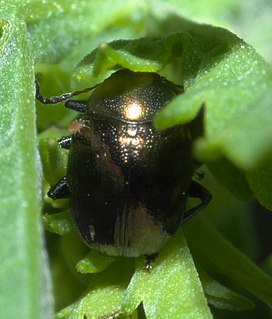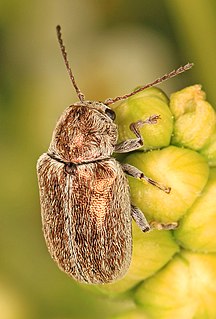
The Eumolpinae are a subfamily of the leaf beetles, or Chrysomelidae. It is one of the largest subfamilies of leaf beetles, including more than 500 genera and 7000 species. They are oval, and convex in form, and measure up to 10 mm in size. Typical coloration for this subfamily of beetles ranges from bright yellow to dark red. Many species are iridescent or brilliantly metallic blue or green in appearance.

The Synetinae are a small subfamily within the leaf beetle family (Chrysomelidae). They are found entirely within the Holarctic, mainly in North America but also appearing in parts of Europe and Asia. The subfamily contains only two genera, Syneta and Thricolema, with a total of 12 described species. The group is sometimes treated as a tribe of Eumolpinae, where they are known as Synetini.

The Spilopyrinae are a small subfamily of the leaf beetles, or Chrysomelidae. They occur in Australia, New Guinea, New Caledonia and Chile. They were formerly considered a tribe of the subfamily Eumolpinae. The group was elevated to subfamily rank by C. A. M. Reid in 2000. However, some authors have criticised this placement, preferring to retain them within the Eumolpinae.
Erythraella is a genus of leaf beetles in the subfamily Eumolpinae. It contains only one species, Erythraella bicuspidata, which is endemic to Socotra. The genus and species were described by Stefano Zoia in 2012. The genus name comes from the Latin name for the Arabian Sea, "mare Erythraeum". The species name, meaning "double pointed" in Latin, refers to the double point of the apex of the aedeagus. The genus is related to Lypesthes and Trichotheca.

Eumolpini is a tribe of leaf beetles in the subfamily Eumolpinae. It is the largest tribe in the subfamily, with approximately 170 genera found worldwide. Members of the tribe almost always have a longitudinal median groove on the pygidium, which possibly helps to keep the elytra locked at rest. They also generally have a subglabrous body, as well as appendiculate pretarsal claws.

Glyptoscelis is a genus of leaf beetles in the subfamily Eumolpinae. There are 38 species of Glyptoscelis described from North, Central and South America. There are also three species of Glyptoscelis known from the West Indies, though they are wrongly placed in the genus. In addition, a single species was described from Hunan, China in 2021.

Colaspidea is a genus of leaf beetles in the subfamily Eumolpinae. It is known from North America and the Mediterranean. It has recently been suggested that the Mediterranean species of Colaspidea are a sister genus to Chalcosicya, and that Colaspina forms a sister genus to the former two combined. It has also been suggested that the North American species of Colaspidea may represent a separate genus.

Typophorini is a tribe of leaf beetles in the subfamily Eumolpinae. The tribe contains approximately 100 genera, which are found worldwide. Members of the tribe are mainly characterized by notches on the tibiae of the middle and hind legs, which are sometimes referred to as antenna cleaners. They also generally have a subglabrous body, as well as bifid pretarsal claws.
Colaspedusa is a genus of leaf beetles in the subfamily Eumolpinae, found in Southeast Asia.
Selmania is a genus of leaf beetles in the subfamily Eumolpinae, found in Africa. Most of the species in the genus were originally placed in Rhembastus.
Nakanaia is a genus of leaf beetles in the subfamily Eumolpinae. It contains only one species, Nakanaia depressicollis. It is found on the island of New Britain in Papua New Guinea. The genus is named after the type locality of the type species, the Nakanai mountains.
Rhynchomolpus is a genus of leaf beetles in the subfamily Eumolpinae. It is distributed in New Guinea, and the name refers to its resemblance to a snout beetle.
Sedlacekia is a genus of leaf beetles in the subfamily Eumolpinae. It contains only one species, Sedlacekia pandani. It is distributed in New Guinea. The genus is named after Josef and Marie Sedlacek, who collected part of the type material.

Dematochroma is a genus of leaf beetles in the subfamily Eumolpinae. It is mostly distributed in New Caledonia, though it is also found on Lord Howe Island, Norfolk Island and Timor. Adult beetles are often found at night feeding on leaves, and the larvae eat roots. It is possible the genus is polyphyletic or paraphyletic.
Cubispa is a genus of leaf beetles consisting of two species from Central America and the Caribbean. It is classified within the tribe Cubispini, which is placed within either the Eumolpinae or the Cassidinae. Beetles in the genus are wingless, and are associated with cloud forests.
Kumatoeides is a genus of leaf beetles in the subfamily Eumolpinae. The genus is endemic to New Caledonia. The genus was first erected in 2018 by Spanish entomologist Jesús Gómez-Zurita. The generic name is the Latin transliteration of the Greek adjective κυματοειδής, meaning "corrugated", referring to the regular striae on the elytra of the beetles.

Euryopini is a tribe of leaf beetles in the subfamily Eumolpinae.

Bromiini is a tribe of leaf beetles in the subfamily Eumolpinae. The tribe contains approximately 120 genera, which are found worldwide. They are generally thought to be an artificial group, often with a subcylindrical prothorax without lateral ridges and covered with setae or scales.
Agetinella is a genus of leaf beetles in the subfamily Eumolpinae. It contains only one species, Agetinella minuta, which is known from Swan River in Western Australia. The genus and species were first described by the German entomologist Martin Jacoby, in an article posthumously published in 1908. The genus was originally assigned to the tribe Eumolpini, but later leaf beetle classifications instead place it as incertae sedis within Eumolpinae.

Macrocoma rubripes is a species of leaf beetle from Europe, Asia and possibly North Africa. It was first described by Ludwig Wilhelm Schaufuss in 1862, as a species of Pseudocolaspis.










